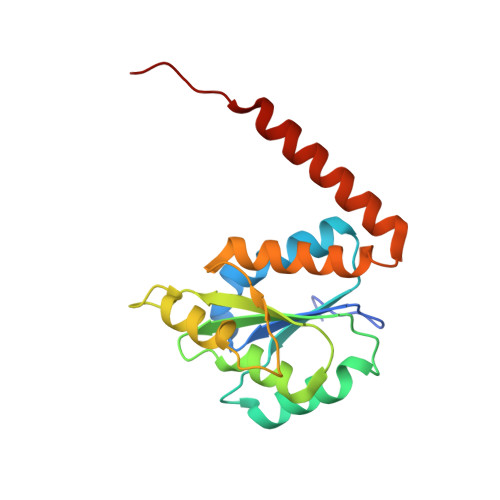Structure-Guided Discovery of N 5 -CAIR Mutase Inhibitors.
Belfon, K.K.J., Sharma, N., Zigweid, R., Bolejack, M., Davies, D., Edwards, T.E., Myler, P.J., French, J.B.(2023) Biochemistry 62: 2587-2596
- PubMed: 37552766
- DOI: https://doi.org/10.1021/acs.biochem.2c00705
- Primary Citation of Related Structures:
4GRD, 6O55 - PubMed Abstract:
Because purine nucleotides are essential for all life, differences between how microbes and humans metabolize purines can be exploited for the development of antimicrobial therapies. While humans biosynthesize purine nucleotides in a 10-step pathway, most microbes utilize an additional 11th enzymatic activity. The human enzyme, aminoimidazole ribonucleotide (AIR) carboxylase generates the product 4-carboxy-5-aminoimidazole ribonucleotide (CAIR) directly. Most microbes, however, require two separate enzymes, a synthetase (PurK) and a mutase (PurE), and proceed through the intermediate, N 5 -CAIR. Toward the development of therapeutics that target these differences, we have solved crystal structures of the N 5 -CAIR mutase of the human pathogens Legionella pneumophila (LpPurE) and Burkholderia cenocepacia (BcPurE) and used a structure-guided approach to identify inhibitors. Analysis of the structures reveals a highly conserved fold and active site architecture. Using this data, and three additional structures of PurE enzymes, we screened a library of FDA-approved compounds in silico and identified a set of 25 candidates for further analysis. Among these, we identified several new PurE inhibitors with micromolar IC 50 values. Several of these compounds, including the α 1 -blocker Alfuzosin, inhibit the microbial PurE enzymes much more effectively than the human homologue. These structures and the newly described PurE inhibitors are valuable tools to aid in further studies of this enzyme and provide a foundation for the development of compounds that target differences between human and microbial purine metabolism.
- Department of Biochemistry and Cell Biology, Stony Brook University, Stony Brook, New York 11794, United States.
Organizational Affiliation:
















